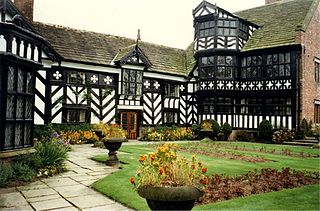
Gawsworth Old Hall is a Grade I listed country house in the village of Gawsworth, Cheshire, England. It is a timber-framed house in the Cheshire black-and-white style. The present house was built between 1480 and 1600, replacing an earlier Norman house. It was probably built as a courtyard house enclosing a quadrangle, but much of it has been demolished, leaving the house with a U-shaped plan. The present hall was owned originally by the Fitton family, and later by the Gerards, and then the Stanhopes. Since the 1930s it has been in the possession of the Richards family. Raymond Richards collected a number of items from other historic buildings and incorporated them into the hall.

Quarry Bank Mill in Styal, Cheshire, England, is one of the best preserved textile factories of the Industrial Revolution. Built in 1784, the cotton mill is recorded in the National Heritage List for England as a designated Grade II* listed building. The National Trust, which runs the site as a museum, calls it "one of Britain's greatest industrial heritage sites, home to a complete industrial community". Quarry Bank Mill was established by Samuel Greg, and was notable for innovations both in machinery and also in its approach to labour relations, largely as a result of the work of Greg's wife, Hannah Lightbody. The relationship between owners and employees is explored in the 2013 television series The Mill.

Wilmslow is a town and civil parish in Cheshire, England, that is 11 mi (18 km) south of Manchester. It is one of the most expensive places to live in the UK after central London, and falls within the Cheshire Golden Triangle.
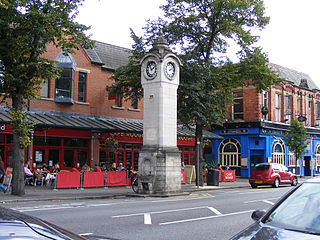
Didsbury is a suburban area of Manchester, England, on the north bank of the River Mersey, 4.5 miles (7.2 km) south of Manchester city centre. The population at the 2011 census was 26,788.

Styal is a village and civil parish on the River Bollin near Wilmslow, Cheshire, England.
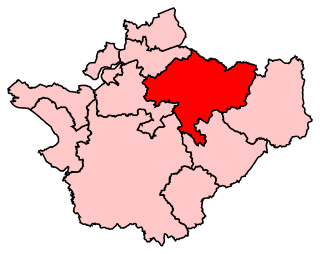
Tatton is a constituency represented in the House of Commons of the UK Parliament since 2017 by Esther McVey, a Conservative.

Acton is a small village and civil parish lying immediately west of the town of Nantwich in the unitary authority of Cheshire East and the ceremonial county of Cheshire, England. The civil parish covers 762 acres (3.08 km2) and also includes the small settlement of Dorfold and part of Burford, with an estimated population of 340 in 2006. It is administered jointly with the adjacent civil parishes of Henhull and Edleston. Historically, Acton refers to a township and also to an ancient parish in the Nantwich Hundred covering a wide area to the west of Nantwich. The area is agricultural, with dairy farming the main industry. Around a third of the area falls within the Dorfold Estate. Historically, agriculture was the major employer, but it has now been overtaken by the service industries, with many residents commuting significant distances outside the parish to work.
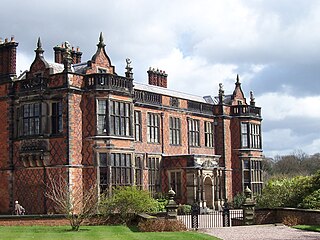
Arley Hall is a country house in the village of Arley, Cheshire, England, about 4 miles (6 km) south of Lymm and 5 miles (8 km) north of Northwich. It is home to the owner, Viscount Ashbrook, and his family. The house is a Grade II* listed building, as is its adjacent chapel. Formal gardens to the southwest of the hall are also listed as Grade II* on the National Register of Historic Parks and Gardens. In the grounds are more listed buildings, a cruck barn being listed as Grade I, and the other buildings as Grade II.

Handforth is a suburban town between Wilmslow, Heald Green and Styal in Cheshire, England. The population of the civil parish as of the 2011 census was 6,266. In the 1960s and 1970s, two overspill housing estates, Spath Lane in Handforth and Colshaw Farm nearby in Wilmslow, were built to re-house people from inner city Manchester.

Cheshire East is a unitary authority area with borough status in the ceremonial county of Cheshire, England. The local authority is Cheshire East Council. The main towns within the area are Crewe, Macclesfield, Congleton, Sandbach and Nantwich. The council is based in Sandbach.

Broxton Old Hall is in Old Coach Road 0.5 miles (1 km) west of the village of Brown Knowl, in the civil parish of Broxton, Cheshire, England. It is recorded in the National Heritage List for England as a designated Grade II listed building.

Burton Manor is a former manor house in the village of Burton, Cheshire, England. It is recorded in the National Heritage List for England as a designated Grade II listed building. At one time an adult education college, this is now closed, but the walled garden is open to the public and is administered by the Friends of Burton Manor Gardens.

Burton Hall is in the small village of Burton 2 miles (3 km) to the southeast of the larger village of Tarvin, Cheshire, England. It is recorded in the National Heritage List for England as a designated Grade II* listed building.

Poole Hall is a Regency mansion at Poole, near Nantwich in Cheshire, England. It dates from 1812–17 and is recorded in the National Heritage List for England as a designated Grade II* listed building. Nikolaus Pevsner considered the interior to be "exceptionally fine". The hall is a private residence and is not open to the public.

Rode Hall, a Georgian country house, is the seat of the Wilbraham family, members of the landed gentry in the parish of Odd Rode, Cheshire, England. The estate, with the original timber-framed manor house, was purchased by the Wilbrahams from the ancient Rode family in 1669. The medieval manor house was replaced between 1700 and 1708 by a brick-built seven-bay building; a second building, with five bays, was built in 1752; the two buildings being joined together in 1800 to form the present Rode Hall.
Fulshaw Hall is a former manor house south of Wilmslow, Cheshire, England. It was built in 1684 for Samuel Finney, a merchant who emigrated to Pennsylvania. In 1735 the house was extended by his son Samuel Finney II. He extended the cross wings and added a service wing, but ruined himself financially in the process. His son Samuel Finney III, miniature painter to Queen Charlotte, restored the house in 1765. In 1886 major additions were made by Richard Lingard Monk in Accrington brick; these were in Jacobean style. The earlier parts of the house are constructed in plum-coloured brick with painted sandstone dressings; the extensions are in Accrington brick with stone dressings. The roofs are in Kerridge stone-slate, and the chimneys are brick. The earlier house is in 2½ storeys, and has a symmetrical seven-bay front. The house is recorded in the National Heritage List for England as a designated Grade II listed building. During the Second World War the building was requisitioned by the War Office and used for training Special Operations Executive agents. After the war it was used as offices by ICI, and later by AstraZeneca. To the north of the hall are the former coach house and stables built by Lingard Monk in 1890. They are constructed in orange brick and have an L-shaped plan. They are also listed at Grade II.
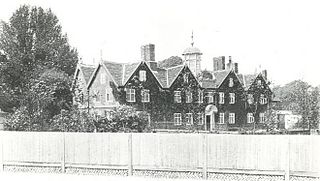
Hawthorn Hall is a former country house in Hall Road, Wilmslow, Cheshire, England. It originated in about 1610 as a timber-framed yeoman house for John Chavman of mnc. It was improved and encased in brick for John Leigh in 1698. Its use changed in the 19th century, and in 1835 it opened as a homeless shelter school. The building has since been used as offices. It is constructed in plum-coloured brick, with a Kerridge stone-slate roof, a stone ridge, and three brick chimneys. Parts of the timber-framing can still be seen in the roof gables, and in an internal wall. The plan consists of a long rectangle. The house is in 2½ storeys, and has a near-symmetrical north front. There are four gables with bargeboards and mace finials. Each gable contains a pair of wooden mullioned and transomed windows. In the centre is a doorway, flanked by plain pilasters, and surmounted by a segmental hood framing a cartouche containing the date 1698. At the top of the hall, above the door, is a small balustrade, behind which is a half-glazed lantern with a cupola and a weathervane. The south front is similar to the north front, although the door is not central. This door is flanked by fluted pilasters, and surmounted by a plaque with a lion rampant. The east front has two gables. The architectural historian Nikolaus Pevsner comments that the house is "good to look at, though conservative for its date". The house, together with parts of the garden walls, is recorded in the National Heritage List for England as a designated Grade II* listed building.

Mobberley Old Hall is a country house in the village of Mobberley, Cheshire, England. It was built in 1612 and extended later in the 17th century. The house stands in gardens which retain part of the moat and ancient yew trees. The house is recorded in the National Heritage List for England as a designated Grade II* listed building, and the grounds contain two Grade II listed buildings.

Norcliffe Chapel is in the village of Styal, Cheshire, England. It is a Unitarian chapel, and is recorded in the National Heritage List for England as a designated Grade II listed building. The chapel was built in 1822–23 by a mill owner for his workers, and was extended by his son in 1867. Further additions were made in 1906. The chapel is built in brick, and is in Gothic Revival style. Since 1977 it has been in the ownership of the National Trust, but continues to function as an active Unitarian chapel.
Wilmslow is a town and civil parish in Cheshire East, England. The area, including the parishes of Handforth and Styal, contains 81 buildings that are recorded in the National Heritage List for England as designated listed buildings. Of these, one is listed at Grade I, the highest grade, eight are listed at Grade II*, the middle grade, and the others are at Grade II. The town has grown from a village to encompass some of the surrounding settlements to become a dormitory town for Manchester. Buildings listed within the town include the church and associated structures, a bridge, and former weavers' cottages. Also in the area is the village of Styal that was developed to house the workers at Quarry Bank Mill. The mill, associated structures, and many of the cottages in the village are listed. Elsewhere the listed buildings include country houses and associated structures, farms and farm buildings, bridges, public houses, chapels, and a viaduct.


















